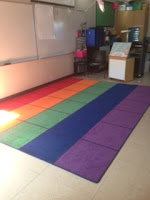As a math coach, I did "dot talks" in hundreds of K - 6th grade classrooms. They are a miracle, I swear it!
So it is with great humility that I relate that, on the fourth day of doing dot talks with my new second grade class, I FINALLY did one that worked with this group. Oh. Em. Gee. The first three weren't just bad....they suuuuuuuucked. Big Time. And it hurts because I think I know where I went wrong.
I'll start at the beginning. I used this dot talk on the first day of school, and it should have worked. I've done it on the first day of school for 1st, 2nd, and 3rd grades.
The general protocol is to show the card with the dot configuration and ask "How many dots do you see?" I show the whole class, then drop the card. (If you hold the card up the whole time, they will just count them, one by one. I want them to rely on parts that they see to put together the total. Counting still happens, but I want them counting the parts they see, not just the whole thing at once.)
When I asked, "How many dots are there?" I got from 4 to 11. Hmmm....should have been my first clue?
When I look at our recording poster, I have to admit, it doesn't look that bad. But it was painful, my friend, I cannot lie. Here, see what I mean?
Still, no worries, I have had terrible dot talks. I mean, as much as I love them and believe in them, there is no question that they can go very badly. Having a bad first dot talk is not even unusual, as I am fairly rusty after summer and most of the time it's my students' first experience with them also. Surely, they will get the hang of it for day two!
Or.... I can pick easily the most confusing dot configuration on the planet, and then I died.
Do you see how arrogant I was when I chose this configuration? After the pain of the first day, I wanted to use that familiar "5 from a die" shape to get the party started. Then, I quickly tacked on three more dots in a "sideways triangle" type shape. (Please excuse all these technical math terms. ahem.) When I stepped back, I saw what they would do, but I underestimated how painful it would be.
Here you go, in case you don't see it yet. Daveelah's way nets 10 dots, and Alex's way nets 8 dots. All 30 students were nonplussed. It was totally fine with them that these two got two different answers. They both looked right, we understood their explanations, so why not?
No need to panic! I'm a professional. I quickly asked their table groups of 4 to determine how many dots there really are. About three quarters of my class was convinced that it was 8 dots, including Daveelah who offered this explanation:
I was pretty sure they would see that the two dots in the middle were counted once in the blue box and once in the green box. We had just done a venn diagram, so we were on solid ground. Fail.
But don't worry, I got out a bucket of chips and asked them if they wouldn't mind terribly BUILDING this thing we had just done, surely they would see that they couldn't build the first one out of counters unless they had the two middle chips stacked double high. Fail.
In fact, it was so hard to get them to even engage in the ponderings....that I was actually getting frustrated. Not a good way to start your math program. So I let it go (after a very small lecture on what I expect when I ask them a question..."I expect you to think about what is asked...you don't wait for somebody else to think, you dive right in!"), praised dear sweet Abi for her excellent model, and slinked out to recess/yard duty, defeated by dots. We never looked back. As far as I know, they STILL think it's fine that this had "two right answers".
"Do you see how it matches, mathematicians? Who sees the five part in our dot card? Can you show us where the five part is in Abi's dots? What is the other part? Can we see it in both places? Abi, we understand what you did!"
I have no pictures of the third day dot talk. It was bad. I'm sure you believe me. Here is day four's dot talk though, and it was perfect! A square of four dots, with one dot added on to either end, and we finally got some traction.
Now just like that (*snap my fingers) we are cooking with fire when it comes to our dot talks. I can actually remember why I love them so much. <3










































